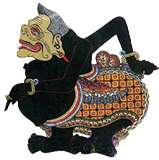Wayang karucil or wayang klitik

Wayang klitik image of Batara Guru
Wayang klitik figures occupy a middle ground between the figures of
wayang golek and
wayang kulit. They are constructed similarly to
wayang kulit figures, but from thin pieces of wood instead of leather, and, like
wayang kulit figures, are used as shadow puppets. A further similarity is that they are the same smaller size as
wayang kulit figures. However, wood is more subject to breakage than leather. During battle scenes,
wayang klitik figures often sustain considerable damage, much to the amusement of the public, but in a country in which before 1970 there were no adequate glues available, breakage generally meant an expensive, newly made figure. On this basis the
wayang klitik figures, which are to appear in plays where they have to endure battle scenes, have leather arms. The name of these figures is onomotopaeic, from the sound
klitik-klitik, that these figures make when worked by the
dalang.
Wayang klitik figures come originally from eastern Java, where one still finds workshops turning them out. They are less costly to produce than
wayang kulit figures.
The origin of the stories involved in these puppet plays comes from the kingdoms of eastern Java: Jenggala, Kediri and Majapahit. From Jenggala and Kediri come the stories of Raden Panji and Cindelaras, which tells of the adventures of a pair of village youngsters with their fighting cocks. The
Damarwulan presents the stories of a hero (
Damarwulan) from Majapahit.
Damarwulan is a clever chap, who with courage, aptitude, intelligence and the assistance of his young lover
Anjasmara, makes a surprise attack on the neighboring kingdom and brings down
Minakjinggo, an
Adipati (viceroy) of Blambangan and mighty enemy of Majapahit's beautiful queen
Sri Ratu Kencanawungu. As a reward,
Damarwulan is married to
Kencanawungu and becomes king of Majapahit; he also takes
Lady Anjasmara as a second wife. This story is full of love affairs and battles and is very popular with the public. The
dalang is liable to incorporate the latest local gossip and quarrels and work them into the play as comedy.
sumber : http://en.wikipedia.org/wiki/Wayang
















